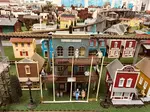 |
Pennsylvania Railroad


The Pennsylvania Railroad was founded in 1846 and went on to become one of the largest railroads in US history at one time managing a budget larger than the US government’s. It controlled about 10,000 miles of track and was affiliated with about 800 other rail companies.
The PRR developed a repair facility in Altoona in 1849 that was later to become the largest in the world. Additional repair shops were developed in Western Pennsylvania and Fort Wayne, Indiana.
Multiple mergers and expansions took place in the late 1800’s and early 1900’s that helped form the Pennsylvania Railroad including acquisition of the North Central Railway, United New Jersey Railroad and Canal Company, Baltimore and Potomac RR, Union RR and later the Philadelphia, Wilmington and Baltimore RR (PW&B).
Passenger service started in 1885 from NYC to Washington, DC called the “Congressional Limited Express”. Later the “Senator” was added from Boston to Washington. The passenger service continued to expand with the New York to Chicago service called the “Pennsylvania Limited”. This was the first passenger service to contain the vestibule between each car allowing movement from one car to another within an enclosed area. In 1902, this line was changed to the “Pennsylvania Special”, and later in 1912, it was replaced by the famous “Broadway Limited”.
In 1910, the PRR began to electrify some of its rail lines using DC current that supplied power via a third rail. This started in the New York Terminal first, then was followed by Philadelphia, but this time, the power was supplied by overhead lines using AC current. This method then became the universal way of electrifying train lines. The “Congressional Limited” became the first passenger service to use electric trains between New York and Washington pulled by GG1-type locomotives. The “Metropolitan” was the first electric passenger train to go into operation from Philadelphia to Harrisburg in 1938. Eventually, over 2600 miles of track became electrified within the PRR system.
In 1916, the PRR began using the slogan “Standard Railroad of the World”, meaning the PRR was the railroad by which all other railroads measured themselves. It was the first railroad to implement many new innovations, including the vestibule as mentioned above. Also they were the first to replace wooden cars with steel-bodied cars. They were also one of the first companies to standardize equipment and processes throughout the entire company, not a common concept in those times. They were even one of the first to standardize their color scheme.
Another first for the Pennsylvania Railroad was to use position-light signals to replace the old semaphore signals. The position-light signal was a round target-type display of up to 9 lights – one in the center and eight in a circle near the edge. The lights used were amber-colored so that they could be seen through fog. Different light displays sent different messages. They were usually displayed as 3 lit lights in a row. For example, if the 3 lights were arranged horizontally, that meant to stop. A vertical display meant to proceed. An “X” meant to take a siding. Later on the 2 outside lights in the horizontal row were changed to red lenses and the center light would be off in the “stop” display. Eventually, these signal displays could be transmitted electronically directly into the engineer’s cab via a track circuit (called cab signaling). The PRR was the first to use this technology also.

The PRR’s steam locomotives were built conservatively and standardized with a certain design style like the rest of the company. They designed and built a large number of their own locomotives. If they needed an outside service they would usually turn to Baldwin and rarely to ALCO since that was a supplier to its competitor – the NY Central.
Diesel locomotive use began in the 1940s beginning with E7s from General Motors Electro-Motive Division. Most were “A” units and some were “B” units (cabless boosters). Later after trying 2 groups of Baldwin engines which proved troublesome, they went back to EMD for E8 “A” unit locomotives in the early 1950s.
The Pennsylvania Railroad built many great passenger stations such as the Broad Street Station in Philadelphia, the Union Station in Washington, DC (built jointly with B&O), the Penn Station in New York City and in Newark New Jersey, the grand 30th Street Station In Philadelphia and the Union Station in Chicago(built jointly with Milwaukee Road and Burlington Route.
Like most large railways, the Pennsylvania Railroad was no stranger to big changes in the mid to late 1900’s. In 1968, it merged with New York Central, one of its main competitors, to form the Penn Central System. Shortly after that, it acquired the New York, New Haven and Hartford Railroad. Unfortunately, the company met with hard times in the 70’s and had to file for bankruptcy. Its assets were then transferred to Conrail in 1976. Conrail was later acquired by Norfolk Southern and CSX, splitting its assets. Now, most of the original PRR is owned by Norfolk Southern.
The Pennsylvania Railroad, however, stands as one of the greatest railroads in the history of the world. It was a great and grand empire in its day and made an undeniably huge contribution to industrialization, transportation and financial development of the United States.
The famous Horseshoe Curve, in operation since 1854, built by the PRR, located near Altoona, PA is a favorite place to replicate by model railroaders. It was originally 2 track, then expanded to 4 tracks in 1898. Corail later removed one of the tracks. The three track "engineering marvel" is now owned and operated by Norfolk Southern.
The following video may help give you some ideas about modeling the PRR...
References:
Pennsylvania Railroad (MBI Railroad Color History)
http://en.wikipedia.org/wiki/PRR
From "Pennsylvania Railroad" to "Railroad History"
From "PRR" to "HomePage""

New Hope, PA
Tracks Newsletter: Sign Up Here!
√ = ad or sponsored link
What's New on BYMRR.com?
Recent Articles
-
Model Railroad Supplies
Dec 16, 25 03:46 PM
We have started a new store to help you build your layout and teach your youngsters about science with STEM products. -
DC and/or DCC on the Same Layout
Mar 09, 25 10:46 AM
How to wire your layout for either DC and/or DCC operation. -
Looking for a locomotive speaker
Nov 24, 24 07:29 AM
First Name: Randy E-Mail Address: bymrr@building-your-model-railroad.com Enter your question: : I am looking for a speaker for a Walthers EMD SD70ACE Locomotive, product number 910-9866. The control b…







